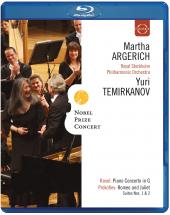Martha Argerich: Nobel Prize Concert 2009
Label: EUROARTS Catalog: 2057894 Format: ARGERICH; ROYAL STOCKHOLM PHILHARMONIC ORCHESTRA; TEMIRKANOVReviewing the DVD version of this concert, given in honor of the 2009 Nobel Prize laureates, Jerry Dubins waxed enthusiastic. I’m more guarded. These are suave readings, but neither in repertoire nor in interpretation does the disc challenge performers or audience, choosing instead to soothe us with the comfort of the established. Yes, like Dubins, I’d eagerly listen to Martha Argerich play just about anything, and this latest return to one of her signature pieces certainly shows off her virtues. On the whole, it’s a fairly benign account, avoiding both the brittle and the angry. It’s certainly less stressful than the edgier and marginally quicker DG reading with Abbado, which helped stake out her early reputation. And her flexible account of the middle movement certainly skirts the pain evoked by Hélène Grimaud in her iconoclastic video performance with Jurowski. Still, Argerich’s new Ravel is both elegant and witty (indeed, a few whimsical spots in the finale are shot through with a nearly Chico Marx-like impishness). All in all, then, while it would have been nice if the occasion had encouraged something more unfamiliar, Argerich fans will doubtless find this attractive—especially given some excellent images of her fingerwork. The unbuttoned Chopin encore is a delight. The rest of the concert is more problematic, what one might call high-level humdrum. The Shostakovich is a stock warm-up piece, and Temirkanov knows it well (in fact, he conducted it to open another gala, the one celebrating the 300th anniversary of St. Petersburg; see Fanfare 33:4). But even with the consummate control of dynamics, especially at the quiet end, the performance is not sufficiently rousing to compensate for the numbing recognition that we’ve been here before—and often. As for the Prokofiev, the reading has plenty of color and variety of articulation (listen, for instance, to the sense of mystery at the center of “Montagues and Capulets” or the sweetness of “Friar Laurence”). But there’s not much blaze to the virtuoso moments (for instance, “Dance”) and the climaxes are too offhand; there’s little crunch to the dissonances at the beginning of “Montagues and Capulets,” and while “Romeo at Juliet’s Grave” is reasonably sad (how could it not be?), it’s far from searing. Then, too, there’s the bizarre ordering. Dubins confuses things a bit when he says “Temirkanov presents the complete Suite No. 2 … then rather anticlimactically follows it with three movements from the Suite No. 1.” In fact, the Suite No. 2 is not complete: “Dance of the Antilles Girls,” which provides respite between the two most emotional movements, has been snipped out. But Dubins is surely right that the decision to put the three movements from the First Suite at the end is an “odd” one. True, other conductors have felt free to combine the suites, abridge them, and shuffle their sequences. Still, I can’t remember offhand another performance that placed “Romeo at Juliet’s Grave” toward the middle—and that ended, instead, with the “Death of Tybalt.” Dubins wonders, “Perhaps at the actual concert, [the First Suite] was offered as an encore.” Given that there’s no applause and no break in continuity after the Second Suite, however, this is an unlikely hypothesis. No, it seems as if Temirkanov simply wanted to end with a bang rather than a whimper. Except for some odd misprints on both box and screen, the production is excellent. For Argerich fans only. © 2012 Fanfare  Price: $52.98 Price: $52.98 |












